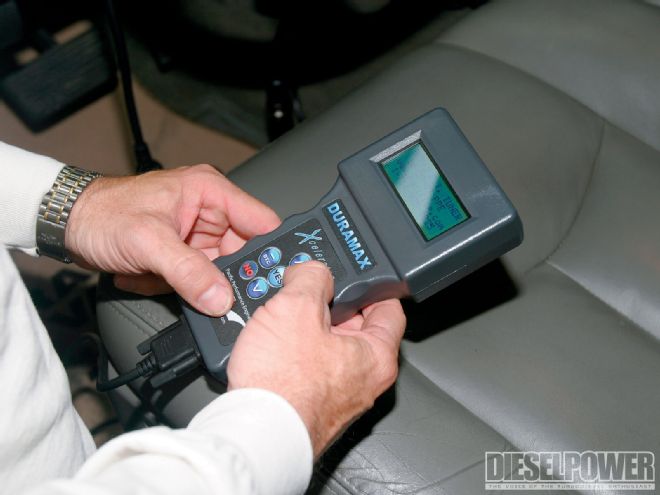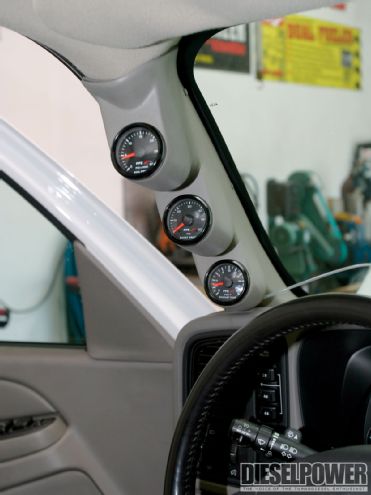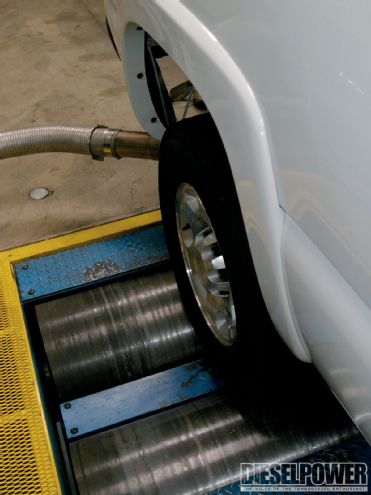Back in "My Next Project Vehicle" editorial (July '10), we brought up the idea of building a sleeper Duramax pickup that would be able to produce more than 600 hp at the wheels yet still retain factory looks and drivability. As it turns out, Pacific Performance Engineering (PPE) was already building such a vehicle: an '06 GMC 2500HD with the 6.6L LBZ Duramax engine. The idea was to test the limits of the truck with a factory CP3 injection pump, then retest soon after with compound turbos. Finally, the single CP3 would be replaced with a set of dual CP3s, and the limits of the factory short-block would be tested with more than 50 psi of boost and plenty of fuel.

| At the dragstrip, the sleeper '06 GMC blasted an eighth-mile time of 8.31 seconds at 83.4 mph-not bad for a mostly stock vehicle.
The Truck
With the goals we had in mind for our joint-venture project, the truck had already received a few upgrades even before we started pushing the limits of the stock injection pump. The transmission had been upgraded to a PPE Stage V Allison 1000, which has proven to be reliable at power levels exceeding 650 hp. The factory airbox was also modified with help from PPE, and a ported fuel rail fitting, shim valve, and 4-inch exhaust were also added. Finally, a Garrett GT3788R turbo was installed to give the truck a slight airflow boost while retaining completely stock drivability.
The Dyno
In order to simulate real-world driving (as close as we possibly could), a coast-down test was run on a Mustang dyno, which eliminates frictional losses due to changes in tire sizes, rearend gearing, and more. While this type of test eliminates variables, it also results in power numbers that are about 10 percent higher than one would normally see, so keep this in mind when you read the horsepower figures.

| All dyno testing was performed on Pacific Performance Engineering's Mustang II load dyno, which was used to simulate tough, real-world conditions.
Our dyno testing was done using a 15-second, loaded, timed pull from 40 mph to 110 mph in Fifth gear on each power level to get a realistic measurement of the type of EGT and fuel rail pressure levels we'd see during a worst-case scenario situation.
Test Number One: PPE Xcelerator Programmer, Stock
With the tuner set to Stock, the '06 GMC put down 335 hp and 671 lb-ft of torque-a little better than we expected-perhaps due to the increased airflow capacity of the GT3788R turbo. We were also monitoring boost, EGT, and fuel rail pressure, which came in at 20 psi, 1,100 degrees, and 26,000 psi, respectively. No problems were encountered here, and EGT and boost levels were completely safe.

| Although the engine looks stock, the factory airbox has been modified with help from PPE, and a ported fuel rail fitting, shim valve, and 4-inch exhaust were also added. Finally, a Garrett GT3788R turbo was installed. The transmission is a Stage V Allison that will support more than 650 hp to the wheels, which leaves plenty of room for future power growth.
Test Two: PPE Xcelerator Programmer, Level 3
With an aftermarket torque converter and TransGo shift kit, a Duramax-powered rig can run on Level 3 and be safe-as far as transmission damage is concerned. At higher power levels, or if the driver is abusive, transmission slippage may occur. As mild as this tune is, it still made good power, peaking at 467 hp and 905 lb-ft of torque. Boost went up slightly, to 22 psi, and EGT was at 1,400 degrees, which is too hot for foot-to-the-floor towing but is OK for a few seconds of freeway blasting. Rail pressure held steady at 26,000 psi.
Test Three: PPE Xcelerator Programmer, Level 5
Our next test was at Level 5, which was the highest setting that allowed us to maintain peak rail pressure at full power. The higher setting dumped in a lot more fuel, and we hit 1,600 degrees on the pyro at the very end of our pull despite our boost levels climbing to 30 psi. After 3,000 rpm, the rail pressure began dropping steadily, ending up at 21,000 psi at 3,500 rpm when the test was stopped. Still, horsepower climbed considerably, hitting 576 hp and 1,068 lb-ft. Although EGT was very hot, it was still only at about 1,300 degrees at peak power and hit 1,600 degrees for a split second. This was good news for us, because that EGT level can only be run for a second or two before parts start to fatigue.
Test Four: PPE Xcelerator Programmer, Level 7
For our final test, we cranked the programmer up to the highest setting, and we can honestly say, don't try this at home! Boost was still at a safe 30 psi, but EGT was a whopping 1,700 degrees, and the fuel rail pressure started to drop as early as 2,500 rpm. By peak power it was down to about 22,000 psi, and by 3,500 rpm, the engine threw a low rail pressure code as it fell to 20,000 psi. Power also dropped due to the lack of injection pressure, as Level 7 made 562 hp and 1,065 lb-ft of torque. Remember, we're doing this type of testing so you don't have to, as running low rail pressure and sky-high EGT levels isn't exactly recommended if you want your truck to live a long and healthy life.

| To keep the truck from downshifting, a GM Tech2 scanner was used to lock the transmission in Fifth. This way, all the dyno runs would be repeatable and consistent.
So what did we learn?
With a programmer as aggressive as the PPE Hot+2 E.T. Race, it's clear that dual CP3 injection pumps are needed at Level 5 and above, and we feel that Level 7 will be too dangerous to use without added airflow in the form of added boost. Extra air will make the engine run leaner, make more power with the same amount of fuel, and lower the EGT out of the danger zone. Stay tuned for parts two and three of this build, in which we install twin turbochargers and add a second CP3 pump.
At the Dragstrip
In an effort to get as much information as possible from this combination, we also took the truck to Irwindale Speedway, where on Level 5 it ran an 8.31-second eighth-mile pass at 83.4 mph (about 13.0 seconds at 104 mph in the quarter-mile) with a 1.84-second 60-foot time. With a race weight of about 7,200 pounds, it was clear we were making around 550 hp at the wheels, which backed up our dyno numbers. To see how those numbers compared to stock, we loaded in the Stock tune and puttered down the track to a 9.79-second time at 72 mph, or about a 15.40-second pass at 90 mph in the quarter-which seems right on to us. Although the turbo upgrade helped some (note the lack of smoke in the lead picture), it's amazing how fast Duramax-powered trucks can be with just a tuner installed.


